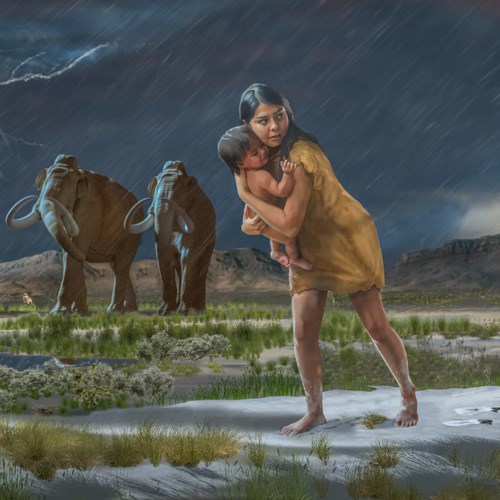

Every day, people from all over the world visit White Sands National Park and leave traces of their adventures. The white dunes of the Tularosa Basin are just a recent occurrence on the geological timeline. At White Sands, we find many remarkable fossilized footprints scattered across Lake Otero. While these footprints are ancient, scientists are still uncovering new evidence of past life.
Tens of thousands of years ago, during the ice age, a giant body of water, Lake Otero, rested within the Tularosa basin. The climate was less arid, and the vegetation was abundant. One could have seen grasslands stretching for miles that would have looked more like the prairies of the Midwest rather than New Mexico’s deserts.
This paradise of lush green life naturally captured the attention of the larger animals of the ice age. Plant eaters such as ancient camels, Columbian mammoths and Harlan’s ground sloth came to Lake Otero to feast on the grasses and trees of the Tularosa Basin. This attracted fearsome predators known as the dire wolf and American Lion. These animals’ footprints remained long after their departure of the wetlands of Lake Otero and eventually became fossilized.
The latest research shows that humans have been living in North America and Tularosa Basin for at least 23,000 years. It was previously thought that humans arrived in North America closer to 13,500 – 16,000 years ago.
Research was conducted to see what could be found below the surface by digging a trench in the gypsum soil on the park’s western playa. Human Footprints were found within different layers of sediment below the surface of the dig site. Above and below these footprints were ancient grass seeds (Ruppia cirrhosa) which were analyzed using radiocarbon dating. It was revealed that the calibrated dates were of 22,860 (∓320) and 21,130 (∓250) years ago.


For 80 years, only a small collection of fossilized footprints were known to exist at White Sands. However, in 2006, a group of scientists noticed dark spots dotting the expanse of the lakebed that appeared to be footprints. Their curiosities lead them to dig up these dark spots in 2009. This led to the discovery of both Harlan’s ground sloth and human footprints. During the 2010s, footprints of a dire wolf were discovered. These footprints were located next to ancient seeds. Scientists dated these seeds to more than 18,000 years ago.
In 2018, researchers discovered what they believe to be footprints of a female. They tell a story that may seem familiar today; her footprints show her walking for almost a mile, with a toddler’s footprints occasionally showing up beside hers. Evidence suggests that she carried the child, shifting them from side to side and occasionally setting the child down as they walked. The footprints broadened and slipped in the mud as a result of the additional weight she was carrying.
Based on stature and walking speed, it appears that most of the footprints in this study come from teenagers and children. As reported in the journal Science, “One hypothesis for this is the division of labor, in which adults are involved in skilled tasks whereas 'fetching and carrying' are delegated to teenagers. Children accompany the teenagers, and collectively they leave a higher number footprints that are preferentially recorded in the fossil record. This pattern is common to all excavated surfaces.” (Bennett, 2021)


Footprints across White Sands have been found coexisting and interacting with extinct ice age animals. One set of footprints shows what appears to be humans stalking a giant sloth. This is demonstrated by human footprints being found inside the footprints of the sloth as they were tracked. Unfortunately for our hunter, there is no evidence that this was a fruitful hunt.
Although the reason for the disappearance of the great animals of the ice age is still debated, most theories do agree that climate change had a major influence. Environments once rich in lush green life began to disappear as those regions began experience less rainfall and higher temperatures. The fossilized footprints of White Sands are probably the most important resources in the Americas to understand the interaction of humans and extinct animals from the ice age.
These fossilized footprints, among other natural and cultural features found in the dunefield, further propelled the movement to re-designate White Sands National Monument into White Sands National Park. As a massive landscape filled with history, White Sands continually proves to be more than just a sandbox.
 A park ranger taking a photo of two parallel paths of human footprints in compact white sand. Fossilized human footprints of an adult and small child in compact white sand." />
A park ranger taking a photo of two parallel paths of human footprints in compact white sand. Fossilized human footprints of an adult and small child in compact white sand." />

Currently the footprints at White Sands are inaccessible.